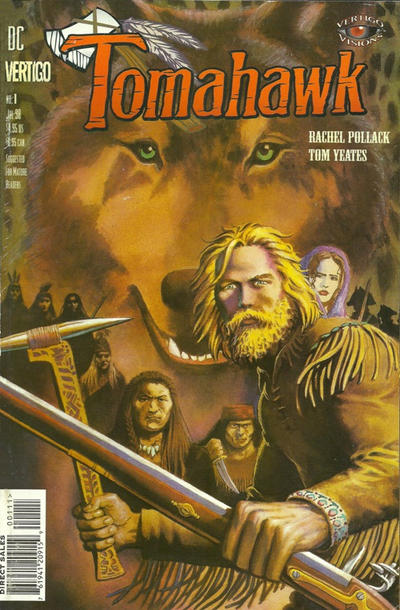Thoughts, reviews, rants, laments, and general chatting about the wonderful world(s) of comic books.
Jun 29, 2018
The 40 Years of Comics Project - Day 1220: Vertigo Visions - Tomahawk, July 1998
I realized, with only a couple of days to go, that I hadn't really had a look at the creators involved in many of these comics. Or, rather, since it's Pride Month, I probably should highlight a few queer creators.
Rachel Pollack is 100% one of the most interesting figures in early 90s comics, and in queer comics specifically. A prodigous writer on the Tarot and the Kabbalah, Ms. Pollack gained some prominence as the writer who took over Doom Patrol when Grant Morrison wrapped his run. Not an easy task, as I still contend that the end of Morrison's Doom Patrol was just about one of the most perfect endings to a story that I've ever seen. Much as I love those characters, if that had been that last I'd seen of them, I'd have been happy. So Ms. Pollack's DP takes a little while to get going, but once we hit the Bandage People and Coagula, it's clear we're in a very different place. And it's so, so queer.
The other stand-out thing about Ms. Pollack is that she's trans. Just let that sink in a moment. In the early 90s, a major mainstream publisher, and remember that this is the heyday of Vertigo comics while Sandman was still a going concern, was employing an openly transgender writer, and letting her tell stories that dealt (and deal) with some of the things trans people experience. The aforementioned Coagula in Doom Patrol is, as far as I know, the first major trans character published in mainstream comics. That's important. But that's well down the pipeline in my Doom Patrol read-through. We've a ways to go yet.
But what about Tomahawk?
This was a very strange comic. It's certainly critical of the treatment of Indigenous Peoples in Revolution-era America. But there's also this strange awakening happening in the main character. Let me try to explain it as I understood it: Thomas Hawke considers the native people to be "savages," but he's not thrilled with the idea of killing them. Certain experiences lead him to be stranded in the wild, where he is taken in by a tribe who basically do to him in order to acculturate to their ways what was done to native peoples: torture, starvation, degradation. He, of course, capitulates and in the end has a spiritual awakening in the forest. It seems that the spirits have dictated that this man should be kept alive, that he is important somehow. He meets Mother Wolf, but very explicitly still sees her through the lens of Christianity. And, in some ways, he still sees himself as superior to the people who took him in. It was a difficult story, and I wonder if it would have made more sense if I had some awareness of who the character of Tomahawk was before this Vertigo re-envisioning. But I couldn't get away from that White Saviour trope, and I was trying to see the story as being critical of it somehow, but I'm not sure I got it.
An interesting comparison that we might make is that Tomahawk cannot fit back into White culture after his transformation - is this perhaps an articulation of the severity of stripping someone of their culture by force, that it's not necessarily something that can be put back together? Now I think I should go back and read it from that perspective.
More to come...
Subscribe to:
Post Comments (Atom)

No comments:
Post a Comment